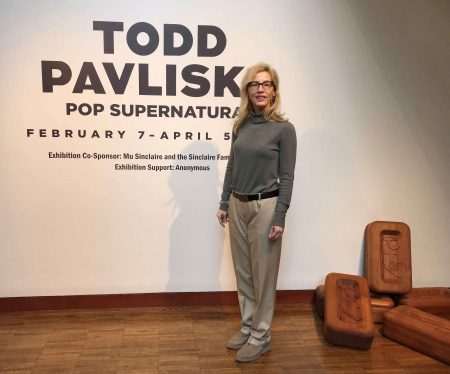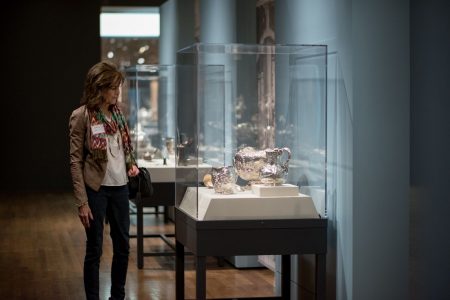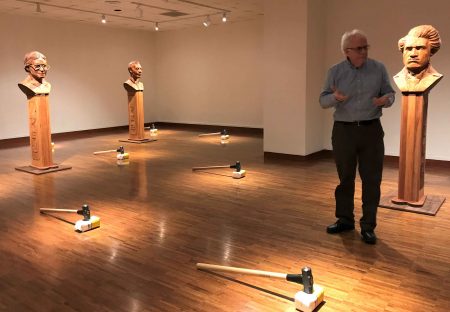From soup to nuts. Ever wonder how a piece of art makes it to the gallery floor? Here’s an inside look at the Cincinnati Arts Association’s Alice F. and Harris K. Weston Art Gallery and the Cincinnati Art Museum and how that happens.
Weston Art Gallery shows an eclectic mix of emerging and professional artists located at 7th and Walnut Streets in the heart of downtown. It is a non-profit exhibition space devoted primarily to the promotion of local and regional artists. Each season is programmed almost two years in advance, according to its literature.
There are two galleries on two levels of 3,500 square feet of exhibition space. The upper gallery and atrium have glass window walls that front 7th & Walnut St. entrances with 24 x 44-feet-high celings and green stone floors. It is best suited to site-specific installations and large-scale sculpture, but can be adapted for painting and photography as well.
The lower galleries (East and West) offer more traditional exhibition space with ten-feet high walls, suspended tile ceilings, a lighting track system and multiple plug outlets.
I traced the arrival of artist Todd Pavlisko’s work from start to finish to give the reader an idea of what goes on behind the scenes of an art exhibit. There is a lot of work that takes place to make an art exhibit happen.
Pavlisko is an Ohio native and New York City-based artist who presents three interconnected bodies of work that reflect cultural change and critique in his show from February 7 to April 5, 2020. But, the process of bringing him back to Cincinnati was not a long or difficult one. He had a history with the Weston beginning in 1995 shortly after college; he had a prior exhibition in 2014, curated a show in 2015 and established a good relationship with the gallery.
There is an architectural rendering of the layout available on the website for artists not familiar with the gallery. https://www.cincinnatiarts.org/weston-art-gallery/about-the-weston/exhibition-space Artists can pre-design their exhibit’s layout, but there are sometimes adjustments made as the show is mounted.
Pavlisko, however, was familiar with the space and had a good idea how he wanted his exhibit entitled Pop Supernatural to be installed. It was a solo exhibition, not always permitted in the gallery. But because gallery director Dennis Harrington and deputy gallery director Kelly O’Donnell knew Pavlisko and his work, they agreed. Pavlisko was given the green light and given the entire space on both levels.
The journey started with conversations between Harrington and Pavlisko about a year ago. They culminated in the acceptance of a show and resulting transfer of the artwork. Pavlisko contacted Harrington about the idea of showing historical figures such as Rosa Parks and Frederick Douglas atop carved wooden PEZ dispensers with a hidden and locked time capsule.
He Initially suggested 20’ tall Homer Simpson kinds of figures, but he became more interested in historical figures and reduced the scale. Harrington said cost was a consideration to bring in 20’ sculptures of mahogany. Most of the sculpture work is done by machine, but there is considerable hand sanding and finishing following the machine process, according to Harrington. The PEZ sculptures were made by a 5 Axis Router CNC (Computer Numerical Control) machine at Cider Press Woodworks in Quakertown, PA.
In addition, there was the exhibit Untitled, Sledgehammer, “metaphorically punctuating the ground with pounding spheres of sledgehammers” resting on bags of sugar and All the Money I Found in a Year, a configuration of hundreds of gold-plated coins into an orb suspended from the ceiling. There are logistics to consider in preparing such an exhibit.
The hammers, purchased online and shipped directly to the gallery, had to move to the floor, but kept in order so no one would trip over them. Harrington said he rode a fine line between aesthetics and danger. The 25 bags of sugar were purchased at a local Kroger grocery store.
Then, there were logistics to bring and hang gold coins from the ceiling on the first floor. Modifications were made. Pavlisko transported the coins in a backpack on the plane he travelled to Cincinnati. The circular Plexiglas supporting the coins was purchased in Cincinnati and custom cut by Stark’s Plastics. shipped directly to the gallery.
The Weston sent two drivers from its installation crew and a 16’ box truck to Rhinecliff, New York (Pavlisko’s residence) to pick up work. Then, the drivers drove to Quakerton, PA to pick up the PEZ sculptures at Cider Press Woodworks. The heads were in a box; the columns in boxes. Everything was strapped to the wall of the truck. It was a three-day trip.
Harrington discovered that the roof had leaked once the truck arrived at the loading dock at The Weston. Even with the pieces wrapped in brown paper, there was concern about water damage. Fortunately, the team brought in a fan and wiped off the water. “That was a frightening moment,” Harrington said.
There is always the logistical issue of a show being performed at the Aronoff. In that instance, other ways to unload artwork are used, whether it’s from the street or a large freight elevator as opposed to loading docks being used for a Broadway performance.
Storage is another factor. There is some storage available in the preparatory space organized by Sly Yeo, exhibition preparator. Weston occasionally uses an unfinished space beneath the P&G Hall orchestra level entry that accommodates storage areas for various departments of Cincinnati Arts Association.
With a staff of only three full-time employees, Harrington stays involved in many details out of necessity and in some cases with enjoyment.
The work is unwrapped at the Weston, and then needs to be installed. According to Harrington, the work for art installers is infrequent, but necessary. “There’s a lot of mundane work installing,” said Harrington, “whether it’s space preparation, moving items or patching up the walls.” And, it takes patience to work with the artists. People have to go along with the artists’ viewpoint,” said Harrington. “There’s an occasional tense moment.” Sometimes, there’s a short window to install the show.
The Weston staff are facilitators in some shows; others they are more hands-on. Some artists aren’t as well organized as others and need guidance. The longest duration to mount a show is two weeks. Logistics are in play. “Anything we can do in advance, we do,” said Harrington. Artists can use scale models of the space to plot their exhibition if they wish.
Harrington and his staff work with artists to discuss all the variables of mounting a show. Harrington himself is an artist and has a good idea what can work in the Weston’s space. Sometimes, the artists are asked to make changes.
Harrington likes to show new work, but “There’s always the risk of failure,” he said. “You want to see what the public thinks,” he added. Sometimes, the crew adjusts on the fly.
Harrington often designs the show, but artists have input. He also takes care of lighting in a theatrical way with track and LED lighting designed to last longer. Upstairs has ambient lighting which affects the way visitors see an exhibit.
Describing the works of art for the viewers is another discussion. Some artists don’t want any labels on the wall; they want the art to speak for itself without interpretation. Others will use handouts of the work with details prepared by Kelly O’Donnell.
There was an introduction of the artist on the wall for the Pavlisko show. Then, O’Donnell created a handout containing the name and description of the work available to read and take home. She describes the process of collecting this information as sometimes arduous. Obtaining the information on a timely basis can be a challenge.
The Weston staff calls on Aronoff employees to help with rigging for large pieces. Stagehands help. The building engineer may assist with complex projects. As part of the Cincinnati Arts Association, Harrington and O’Donnell engage with many departments in the building to accomplish their goals of mounting an exhibit, no small undertaking.
Every two months a show is turned over, so the process begins again. O’Donnell says, “The Weston has a reputation for elegant installation. You have to enjoy this process.” It lives up to its billing. There is no detail left untouched.
There is an annual dedicated audience of 25,000 for the Weston, although Aronoff attendees often stop by the galleries on the way to a play. The Weston hosts approximately 8 to 10 exhibitions annually with an average of 20 artists. Some lend themselves to a solo show. There is one group show annually.
Staff at the Cincinnati Art Museum review the design for a show sometimes a year to several months or more in advance. Exhibition designer Lauren Walker executes a design with Vectorworks, a computer program, based on many conversations with curators about their vision for a specific exhibit. A finished design may be available within three to four months with the capability to plug the actual artwork in and see how the furniture is going to look. Shop drawings go to the carpentry shop. Approximately 80% of case work is built on site to keep costs low.
Head of design and installation Kim Flora describes her efforts with installation. She sees the hashed out design and frequently measures doorways, artwork, casework, walls and crates with her tape as she works in an older building to execute a project throughout the building. Her job requires that she think through the best route ahead of time to ensure the safety of the art and the people moving it. There is also the making of mounts done by a preparator to support objects. Consideration is given toward what is the best way to see an object.
Curators are actively involving in planning an exhibit. They work collaboratively on every decision. Flora said “We do a good job of driving us forward.”
There are six preparators and two carpenters who meet with the curator and conservators to flesh out details of the exhibit. They want to ensure the safety of the display. This may take several months.
The Gorham Silver Exhibition is a good example of a show with multiple logistical requirements. Several years of work by Elizabeth Williams, curator of Decorative Arts and Design, Rhode Island School of Design, and Amy Miller Dehan, CAM’s curator of Decorative Arts and Design, went into this project. Rhode Island School of Design, organizers of the show, sent four semi-trucks from Providence, RI to deliver 52 crates filled with silver objects plus casework. Couriers accompanied the trucks to be sure of their condition.
Flora said her team unpacked the crates while she supervised. There were large crates with Gorham silver in smaller boxes. There were labels on the cases as to the location and which gallery. There were also deliveries from the Dallas Fine Arts Museum, the High Museum of Art, the Metropolitan Museum of Art, Museum of Fine Arts Boston, Chicago History Museum and Nelson-Atkins Museum of Art as well as private collectors from all over the world. Silver was polished and wiped down before displayed. The large coffee pot and spoon at the opening of the exhibition were treated with wax to preserve the finish. Flora said the process of unpacking and preparing was quite tedious.
Objects were then handed to her crew to install. They added silica gel to the cases in order to maintain humidity so the silver doesn’t tarnish. To unpack and install the show including lighting and labels took just under fourteen days.
Lighting was the next project. The team had to be conscious of work on paper and screen down the light. Flora said, “Lighting is an art form in itself.”
Labels came from the Design and Dissemination Department.
Often, however, there is a 24-hour acclimation period when the cases remain unopened in the event of a climate change. In the case of the Gorham exhibit, case work was specific to the show and not built at CAM.
Walker said, “People don’t realize how much energy and effort go into these exhibits.” It is what happens behind the scenes that make them a reality. And, it is often blood, sweat and tears.
Walker calls herself a pretend architect as she makes numerous sketches that deal with a 3D space layout for the Romare Bearden exhibit, for example. She deals with the look and feel of an exhibit by sitting down with the curator and see how they envision the show. The curator explains how you see this exhibit coming together.
“Each exhibit has a personality,” said Walker. “I take the information and do research myself.” For the Bearden exhibit, she asked, “What is the heart of the show?” Harlem Renaissance and collage technique were the answers. She paid attention to the bright colors that Bearden used, the technique of ripping paper and an urban city scape. She brainstormed with other colleagues to get the look and feel of the show. Low light was required, however.
Walker prepared research on the design detail of the show filled with schematic ideas and presented it to curator Julie Aronson. Curators have final approval, but it is a collaborative process.
“Once the idea is approved, I take the ideas from broad to drawing objects to scale, drawing graphics,” and creating a floor plan, Walker said. She hones in on more specific details and blocks out a basic size and thinks about the case.
She works closely with the painters and carpenters to accomplish the look of the exhibit. She creates construction document drawings that shops can read. “Art takes priority,” she said. A team of preparators do the mounts. “There is a lot of conversation.”
“I am in the middle of the seesaw, involved in the process of the production of the gallery. I check in as communicator of the design,” Walker said.
Walker keeps accessibility in mind. The goal is to make sure all visitors can enjoy art. “Accessible design is a good thing,” she added. Her reward is to see the final project.








